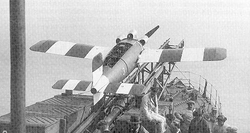Engineering:RAE Larynx
From HandWiki
Short description: Early British pilotless aircraft

"RAE Larynx on cordite fired catapult of destroyer HMS Stronghold, July 1927. The man on the box is Dr. George Gardner, later Director of RAE."[1]
The Royal Aircraft Establishment Larynx (from "Long Range Gun with Lynx engine") was an early British pilotless aircraft, to be used as a guided anti-ship weapon. Started in September 1925, it was an early cruise missile guided by an autopilot.[1]
Design
A small monoplane powered by a 200 hp (150 kW) Armstrong Siddeley Lynx IV engine, it had a top speed of 200 mph (320 km/h), faster than contemporary fighters.[2]
It used autopilot principles developed by Professor Archibald Low[citation needed] and already used in the Ruston Proctor AT, a radio controlled biplane that was intended to be used against German Zeppelin bombers.[citation needed]
Project history
- First test: 20 July, 1927. Launched from cordite-powered catapult fitted to the S class destroyer HMS Stronghold. Crashed into Bristol Channel.[3]
- Second test: 1 September, 1927. Thought to have flown 100 miles (160 km) and was then lost.
- Third test: 15 October, 1927. 112 mile (180 km) flight, hit five miles from target.
- Two more launches in September and October 1928 from HMS Thanet, another S class destroyer.[3]
- Two launches May 1929. Launched from land, one overflew target and other was successful.
Specifications
Data from [2]
General characteristics
- Powerplant: 1 × Armstrong Siddeley Lynx IV radial engine, 200 hp (150 kW)
- Propellers: 2-bladed
Performance
- Maximum speed: 200 mph (320 km/h, 170 kn)
See also
- Hewitt-Sperry Automatic Airplane
- Kettering Bug
- V-1 flying bomb
References
- ↑ 1.0 1.1 Werrell, Kenneth P. (September 1985). The Evolution of the Cruise Missile. Maxwell Air Force Base , Montgomery, Alabama: Air University Press. p. 17. AD-A162 646. https://media.defense.gov/2017/Apr/07/2001728474/-1/-1/0/B_0006_WERRELL_EVOLUTION_CRUISE_MISSILE.PDF#page=33.The RAF began work on a true "flying bomb" in September 1925. Compared with the RAE 1921 Target missile, the Larynx (Long Range Gun with Lynx Engine) was smaller, heavier, and faster. In fact, a 200 hp (150 kW) Lynx IV engine gave the device a top speed of about 200 mph (322 km/h), making it faster than contemporary fighters.
- ↑ 2.0 2.1 Gibson, Chris; Buttler, Tony (2007). British Secret Projects: Hypersonics, Ramjets and Missiles. Hinckley: Midland. ISBN 978-1-85780-258-0. OCLC 310094852.
- ↑ 3.0 3.1 Everett, H.R. (2015). Unmanned Systems of World Wars I and II. Cambridge MA: MIT Press. p. 15. ISBN 978-0-26202-922-3.
External links
- (1.0) The Aerial Torpedo
- Remote Piloted Aerial Vehicles : The 'Aerial Target' and 'Aerial Torpedo' in Britain
- Interwar British Experiments with Pilotless Aircraft pay to access
- "Automatic Flight" a 1958 Flight article
- The Mother of All Drones - Article Vintage Wings of Canada
 |

